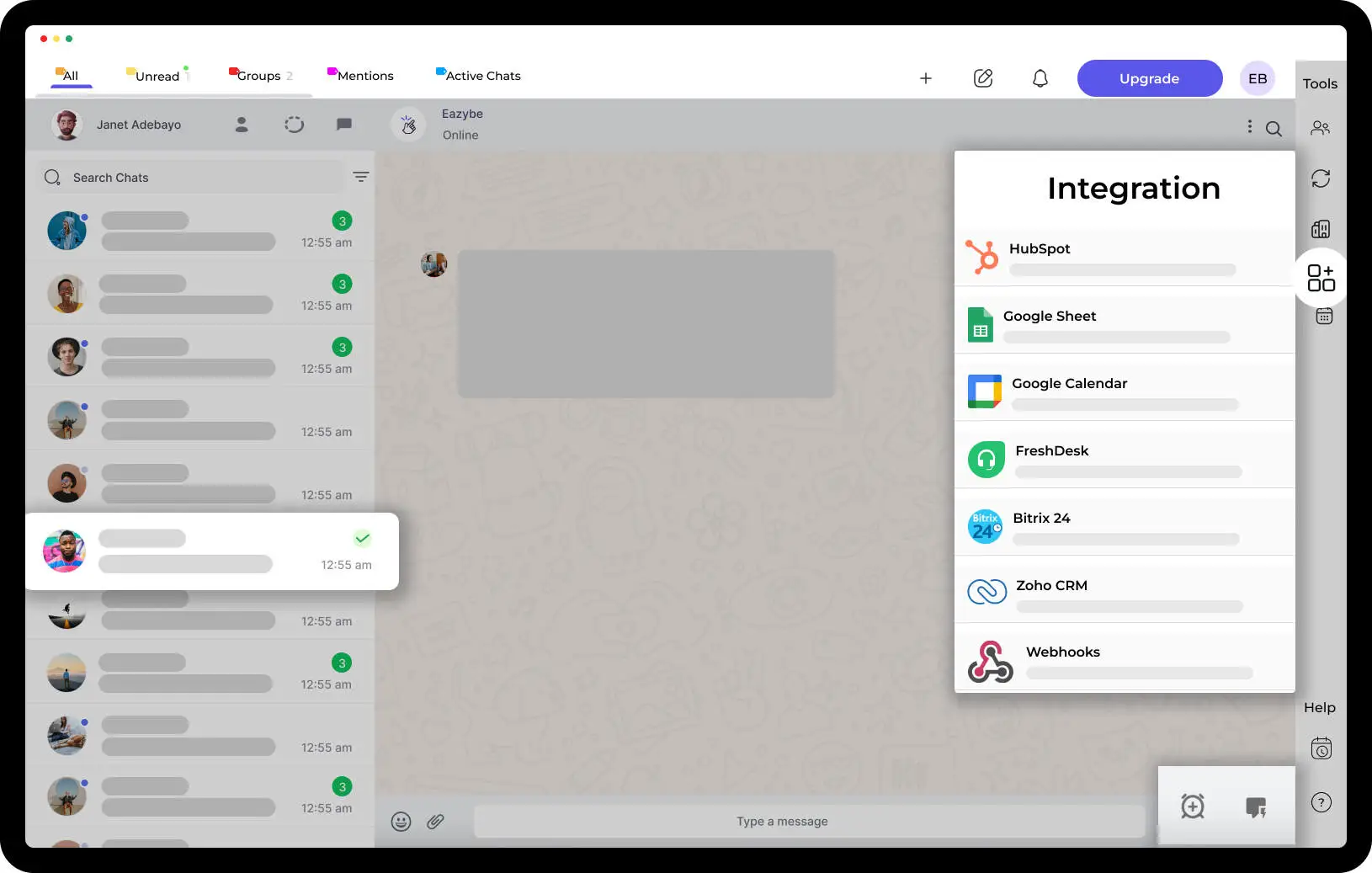
WhatsApp OTP: How To Send OTP With WhatsApp in 2024

WhatsApp OTP in today's digital age, One Time Passwords (OTP) are a critical element of authentication for various online services. OTP is a unique numerical code generated by a service provider and sent to a user's mobile phone number.
This code is used to verify the user's identity during the registration process or when logging in to an online account. Traditionally, service providers send OTPs via SMS, but with the increasing popularity of WhatsApp, businesses are looking to leverage this platform to send OTPs. In this blog, we will discuss how to send OTP with WhatsApp in 2023.
Table of Contents
- Difference Between SMS OTPs & WhatsApp OTPs
- How To Send OTP On WhatsApp Using Business Account?
- Get Started By Using A WhatsApp Business API Account in 2023
- Send OTPs Through WhatsApp Using WhatsApp Business API
- Best Practices Of Sending OTPs Via WhatsApp
- How To Send WhatsApp OTP Using Shared Numbers in 2023?
- Limitations Of Sending WhatsApp API From Shared Numbers
- Advantages Of Sending OTPs On WhatsApp in 2023
- How To Send WhatsApp OTPs on Desktop?
- Wrapping Up
- WhatsApp Business Tool You Should Know About
Difference Between SMS OTPs & WhatsApp OTPs
Before we dive into the technical details of sending OTPs with WhatsApp, let's understand the difference between normal SMS OTP and WhatsApp OTP.
- A traditional SMS OTP is sent via text message to a user's mobile number. In contrast, a WhatsApp OTP is sent through the WhatsApp platform, which requires users to have a WhatsApp Business account.
- WhatsApp OTP is a more secure and reliable option for sending OTPs as it leverages end-to-end encryption, which means that only the sender and the recipient can access the message.
- WhatsApp OTPs are delivered instantly, and users do not have to switch between different apps to receive the OTP.
How To Send OTP On WhatsApp Using Business Account?
To send OTP with WhatsApp, the first thing you will need is a mobile number and a WhatsApp Business account. If you don't already have a WhatsApp Business account, you can create one by visiting the WhatsApp Business website and following the steps to register.
Once you have created your account, the next step is to register for the WhatsApp Business API. The API allows businesses to integrate their systems with WhatsApp, enabling them to send automated messages, including OTPs.
Read About: 15 WhatsApp Business Description Templates in 2023
Get Started By Using A WhatsApp Business API Account in 2023
To register for the WhatsApp Business API, you will need to visit the WhatsApp Business API page and follow the instructions provided. The registration process can take several days, as WhatsApp reviews each application to ensure compliance with their policies.
Send OTPs Through WhatsApp Using WhatsApp Business API
Once your registration is approved, you can start sending OTPs through your WhatsApp Business account. Here are the steps required to send OTPs through WhatsApp:
- Create an OTP template: To send an OTP through WhatsApp, you will need to create an OTP template that meets WhatsApp's guidelines. The template should include the message that the user will receive and the format of the OTP. Make sure to include the user's name or other identifiable information in the message to avoid confusion.
- Integrate your system with WhatsApp: Once you have created your OTP template, you will need to integrate your system with WhatsApp using the WhatsApp Business API. This will enable you to send automated messages, including OTPs.
- Send the OTP: Once your system is integrated with WhatsApp, you can send the OTP to the user's WhatsApp account. The OTP will be delivered instantly, and the user can easily access it without leaving the app.

Best Practices Of Sending OTPs Via WhatsApp
Now that we have discussed the steps required to send OTPs through WhatsApp, let's take a look at some best practices for creating OTP templates on WhatsApp. Here are some templates that you can use to create the best OTP messages on WhatsApp:
- Generic OTP template:
Dear [Name],
Your OTP for [Service Name] is [OTP Code]. This OTP is valid for [Timeframe]. Please do not share this OTP with anyone.
Thank you, [Service Name] Team
- Login OTP template:
Dear [Name],
Your OTP for logging into your [Service Name] account is [OTP Code]. This OTP is valid for [Timeframe]. Please do not share this OTP with anyone.
Thank you, [Service Name] Team
- Transaction OTP template:
Dear [Name],
Your OTP for the transaction on [Service Name] is [OTP Code]. This OTP is valid for [Timeframe]. Please do not share this OTP with anyone.
Thank you, [Service Name] Team
These templates can be customized to suit your business requirements and can be used for a variety of use cases.
How To Send WhatsApp OTP Using Shared Numbers in 2024?
It is essential to note that WhatsApp Business accounts offer two types of phone numbers for sending OTPs: shared numbers and dedicated numbers. Shared numbers are phone numbers that are shared by multiple businesses, while dedicated numbers are exclusive to a single business.

Limitations Of Sending WhatsApp API From Shared Numbers
Sending OTPs through shared numbers can be an affordable option for small businesses, but it comes with its own set of limitations. For instance, shared numbers are not customizable, and businesses cannot use their brand name or logo in the message. Additionally, messages sent through shared numbers may not always be delivered immediately, which can impact the user experience.
On the other hand, dedicated numbers are a more premium option that allows businesses to customize their messages and use their brand name or logo in the message. Dedicated numbers offer a higher level of security and reliability, as messages sent through dedicated numbers are delivered instantly and have a higher open rate.
Advantages Of Sending OTPs On WhatsApp in 2024
One of the advantages of using WhatsApp for sending OTPs is that WhatsApp has a significantly higher open rate compared to SMS and email. According to a report by HubSpot, WhatsApp messages have an open rate of 98%, compared to an open rate of 20% for email. This means that WhatsApp messages are more likely to be read and acted upon by users, making it an effective channel for delivering OTPs.
How To Send WhatsApp OTPs on Desktop?
To send OTPs through WhatsApp, businesses can use the WhatsApp Web or the WhatsApp Chrome Extension. WhatsApp Web allows users to access their WhatsApp account on a web browser, while the WhatsApp Chrome Extension enables users to send and receive WhatsApp messages directly from their Chrome browser.
To send OTPs through WhatsApp Web or the WhatsApp Chrome Extension, follow these steps:
- Open WhatsApp Web or the WhatsApp Chrome Extension on your browser.
- Click on the chat icon and select the contact to whom you want to send the OTP.
- Type the OTP message in the chat window and click on send.
- The OTP will be delivered instantly to the user's WhatsApp account.
Wrapping Up
In conclusion, sending OTPs through WhatsApp can be a more secure and reliable option compared to traditional SMS OTPs. Businesses can leverage WhatsApp's end-to-end encryption and higher open rates to deliver OTPs to their users. To send OTPs through WhatsApp, businesses will need to have a WhatsApp Business account and register for the WhatsApp Business API.
They can create OTP templates that meet WhatsApp's guidelines and send OTPs through shared or dedicated phone numbers. Businesses can use WhatsApp Web or the WhatsApp Chrome Extension to send OTPs to their users. By following these best practices, businesses can effectively use WhatsApp as a channel for delivering OTPs and improving the overall user experience.

WhatsApp Business Tool You Should Know About
We understand the common business problems that you may face while using WhatsApp as your daily business tool. There is a Business Tool which can literally do everything for you. We are talking about The Eazybe Chrome Extension. It is a business productivity tool that allows users to perform a variety of tasks quickly and easily directly from their Chrome browser & WhatsApp Web account. Here are some of the things that you can do with the Eazybe Chrome Extension:
- Quick Replies: Eazybe WhatsApp Chrome Extension allows users to send quick replies to their clients, colleagues, friends, and family members too. You can set a quick reply and send the message to them whenever you are not available, driving, or doing anything that needs your attention.
- Schedule Messages on WhatsApp: It it very tiring to actually remember as to when you need to message someone. You can automate this process by scheduling messages on WhatsApp using Eazybe Chrome Extension. Read About: How To Schedule Messages On WhatsApp.
- Sync Your CRMs like HubSpot, Zoho, Salesforce, etc.: The Eazybe Chrome Extension comes with many built-in integrations where you can sync your favorite CRM directly into your WhatsApp Web. You can sync contacts, tasks, notes, and every data available in your CRM with your WhatsApp Web. Read About: How To Integrate CRM with Your WhatsApp.
- Sync Google Sheets: Google Sheets is also a popular free CRM to manage your leads, client data, and for keeping a track of your conversions. But switching between apps while dong this might be tiring sometime. You can easily sync every piece of information with your WhatsApp Web. Read About: How To Integrate Google Sheets With WhatsApp.
- Create Teams Workspace: Manage your team on WhatsApp Web directly using Eazybe Chrome Extension. This workspace will allow you to see your team’s pending tasks, their leads, notes, conversations and everything that you’ll ever need right at your WhatsApp.
- Use ChatGPT on WhatsApp: The Eazybe Chrome Extension includes a powerful AI tool built with the language of ChatGPT. You can use ChatGPT while sending any message and just hit enter to send it instantly, you can also create custom message templates and save them.
Read About: How To Use ChatGPT On WhatsApp.
How To Install Eazybe Chrome Extension?
- Open Google Chrome Web Store and search “Eazybe” or Click Here.
- Login into Your WhatsApp Web.
- Enjoy The Eazybe Chrome Extension Right At Your Fingertips.



.svg)



